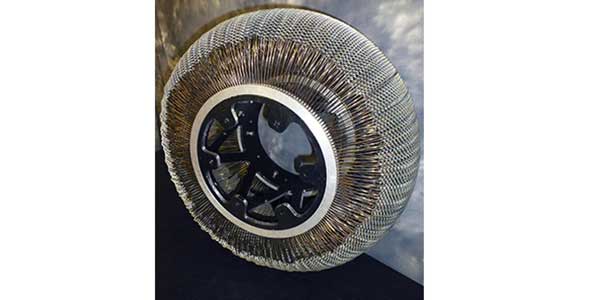
Researchers at NASA’s Glenn Research Center have developed an alternative to traditional pneumatic tires for future missions to Mars. The Superelastic Tire was developed specifically to equip a new generation of ground vehicles for Mars exploration.
The tire, developed from NASA’s existing Spring Tire technology and inspired by the tires used in the Apollo program, utilizes shape memory alloys capable of flexing and withstanding deformation without losing its original shape. By incorporating shape memory alloy as a radial stiffener, the Superelastic Tire is able to increase load-carrying capacity and matching traction performance of conventional pneumatic tires. With no need for an inner frame or pressurized gas, the tire is lighter and safer, as there is no possibility of puncture.
According to NASA, the benefits of the Superelastic Tire include:
- Safety: Eliminates the possibility of puncture failure
- Strength: Can withstand excessive deformation
- Robustness: Can be configured for high traction on various terrains
- Simplicity: Eliminates the need for air
- Versatility: Tire stiffness can be designed to limit energy transferred to vehicle
- Reduced Weight: No inner frame needed for the tire/wheel assembly
Potential applications include:
- All-terrain vehicle tires
- Military vehicle tires
- Construction vehicle tires
- Automobile tires
- Heavy equipment tires
- Agricultural vehicle tires
- Aircraft tires
The Technology
This NASA Glenn innovation comprises a non-pneumatic, compliant tire utilizing shape memory alloys (mainly NiTi and its derivatives) as load bearing components. These shape memory alloys are capable of undergoing significant reversible strain (up to 10%), enabling the tire to withstand an order of magnitude more deformation than other non-pneumatic tires before undergoing permanent deformation. Commonly used elastic-plastic materials (e.g. spring steels, composites, etc.) can only be subjected to strains on the order of ~ 0.3-0.5% before yielding. Hence, the use of a NiTi shape memory alloy yields a superelastic tire that is virtually impervious to plastic deformation. In addition, the utilization of shape memory alloys provides enhanced control over the effective stiffness as a function of the deformation, providing increased design versatility. For instance, the Glenn Superelastic Tire can be made to soften with increased deflection, reducing the amount of energy transferred to the vehicle during high deformation events. In addition, the use of shape memory alloys in the form of radial stiffeners, as opposed to springs, provides even more load carrying potential and improved design flexibility. This type of compliant tire would allow for increased travel speeds in off-road applications.
Article courtesy TIRE REVIEW.


